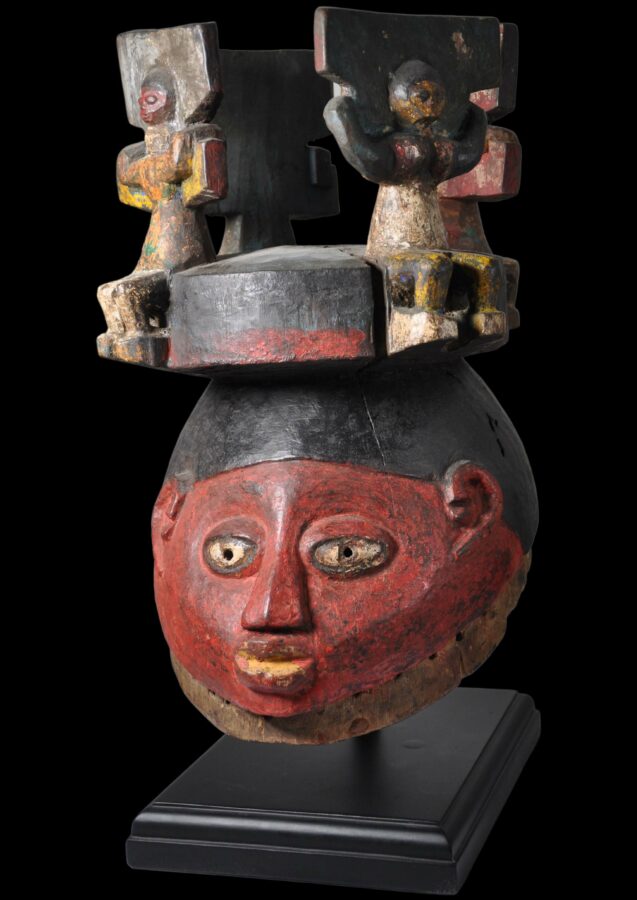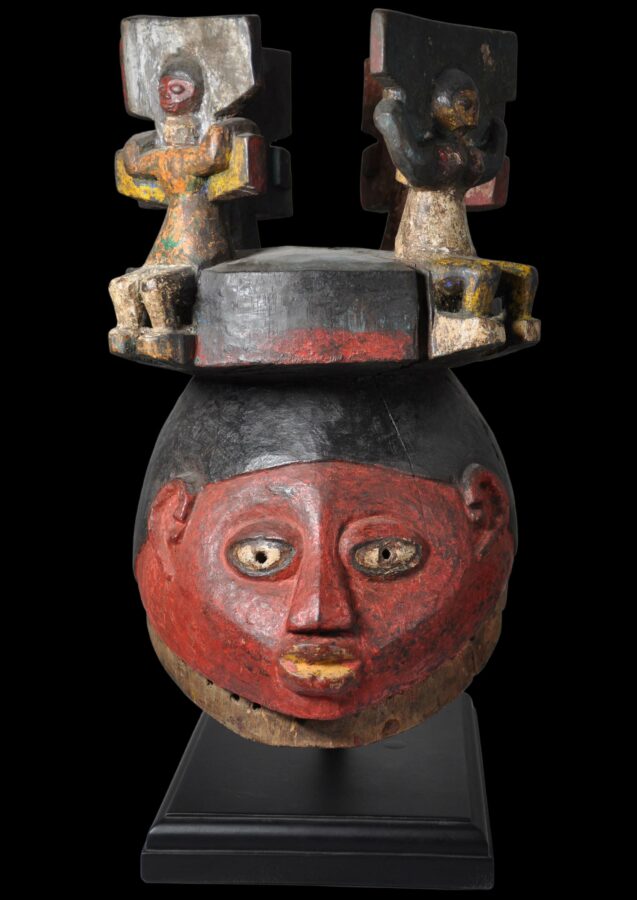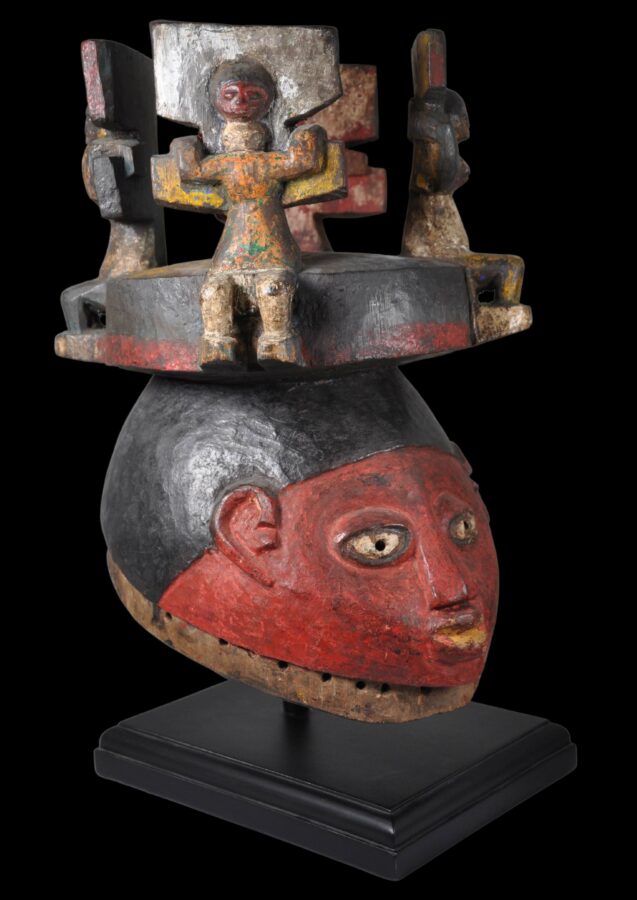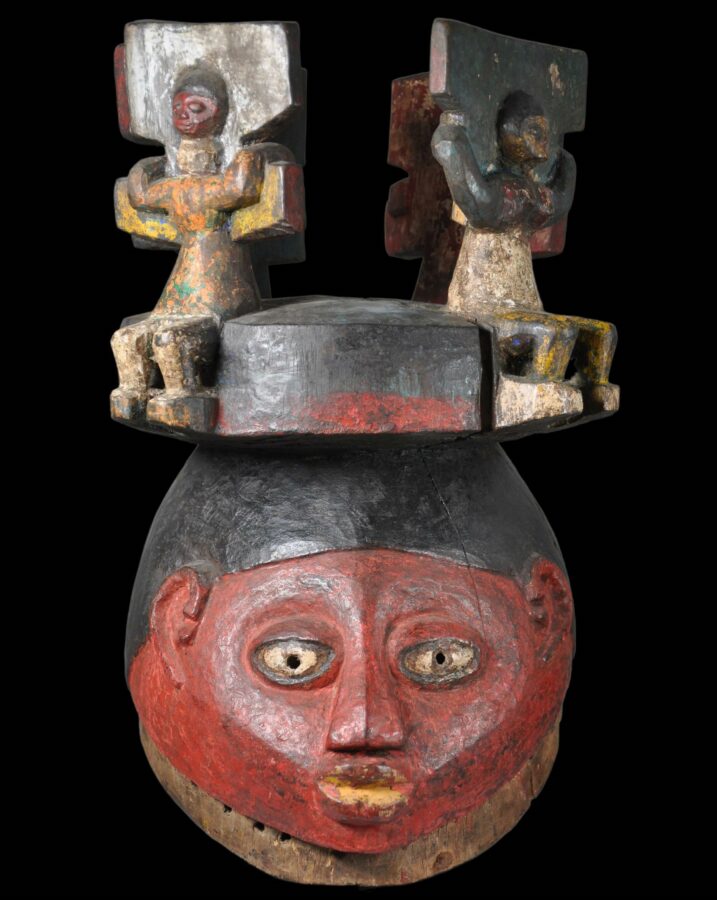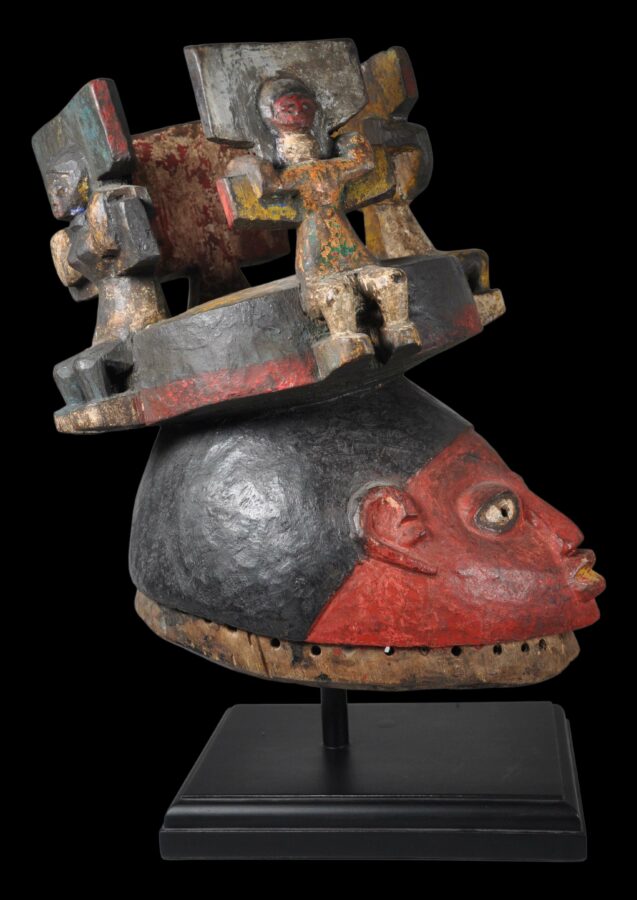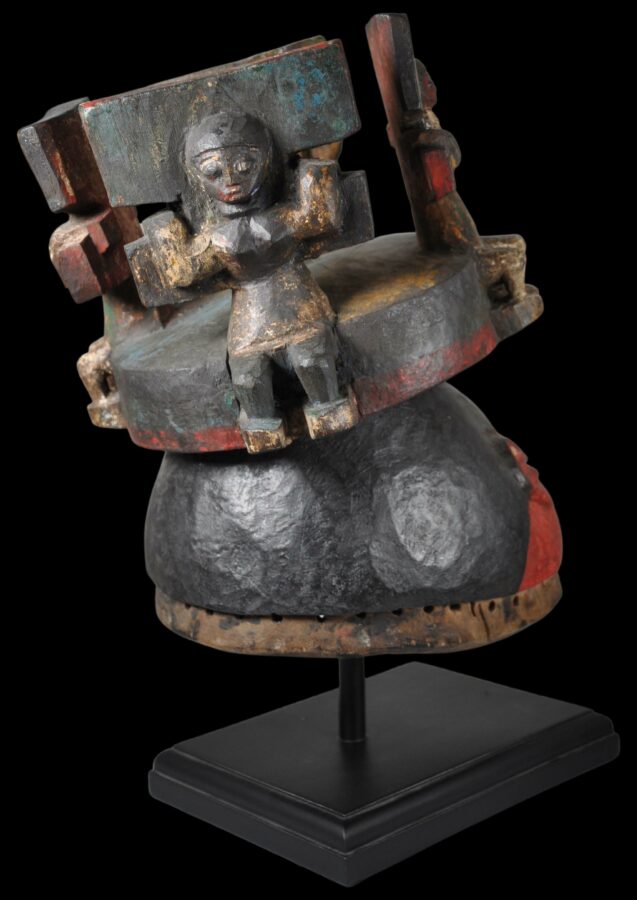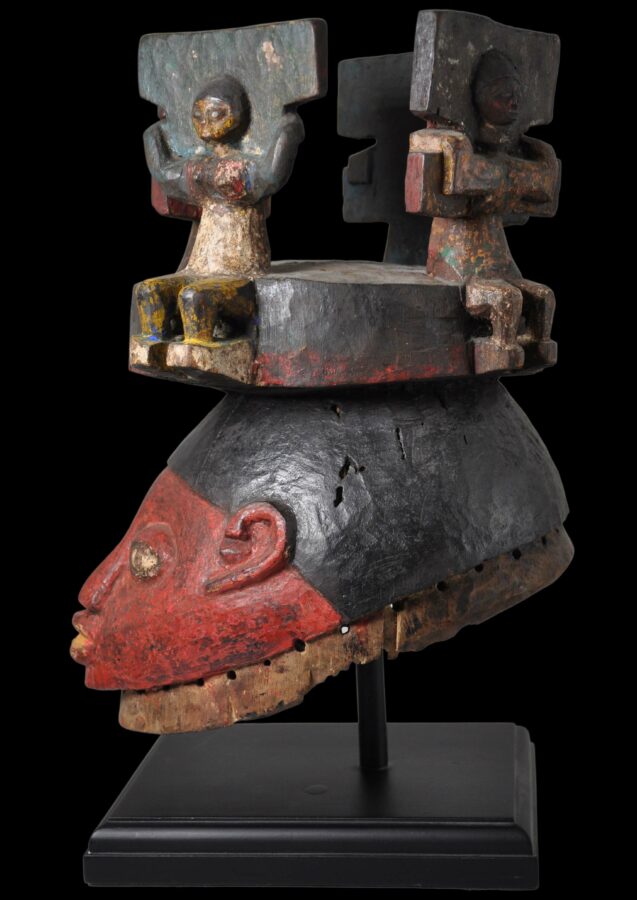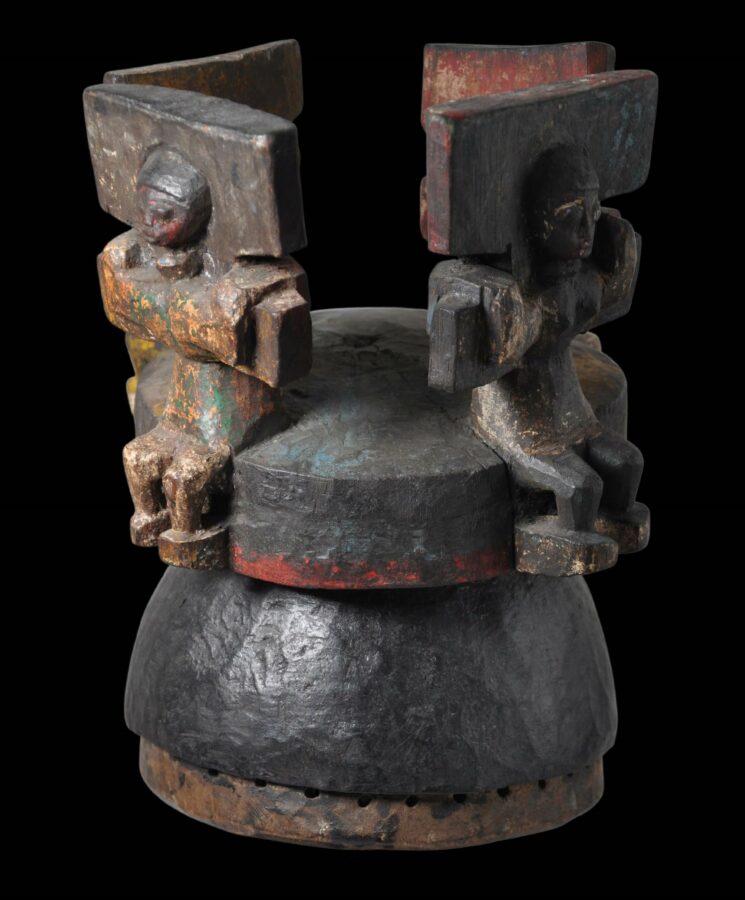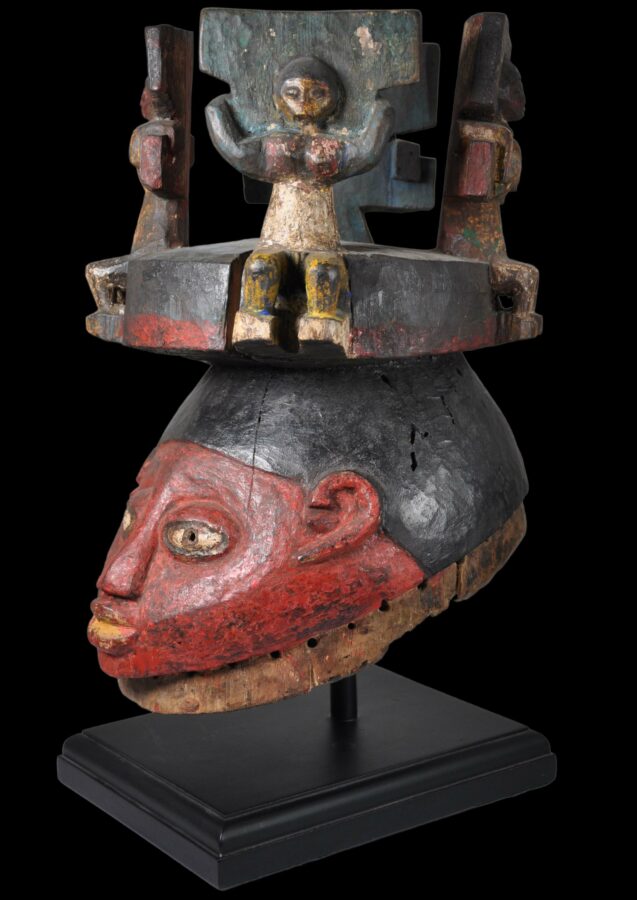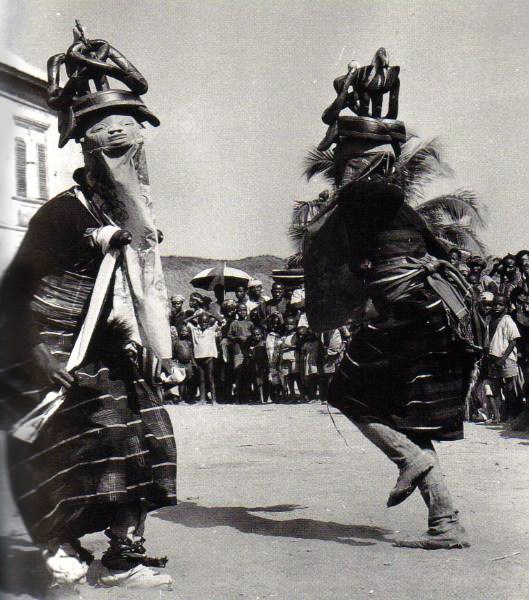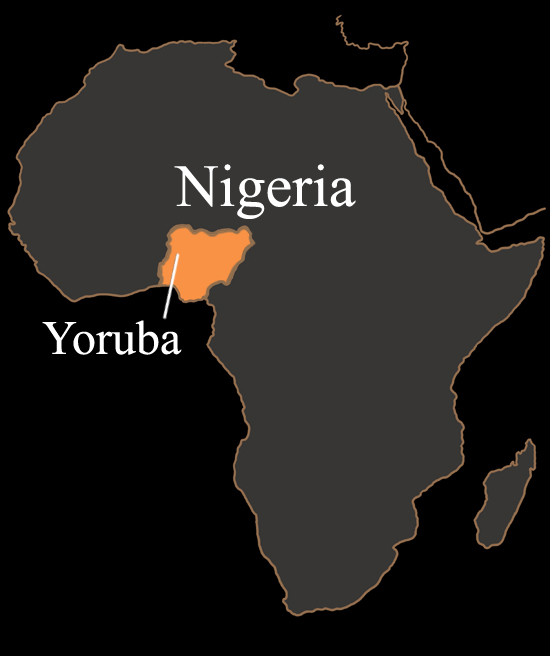Enquiry about object: 944
Yoruba Gelede Dance Headdress
Yoruba People, Nigeria circa 1940
height: 34cm, length: 22cm, width: 27cm
Provenance
UK art market, formerly in an Oxford collection.
“The eyes that have seen Gelede have seen the ultimate spectacle” – a Yoruba saying.
This somewhat idiosyncratic wooden headdress used in Yoruba Gelede ritual dances balances symmetry and proportion. It is in red, black, white, blue, yellow and green polychrome. There is evidence of repainting – not unusual for headdresses that were valued and thus used and re-used. It retains a good patina from obvious age and use. There is an age-related split at the head.
The red human face is sensitively carved with delicate features, including compressed lips, a fine nose, small almond-shaped eyes with circular pierced pupils, and a gently sloping forehead framed by curvilinear ears. The eyes are not classically bulgy and heavily lidded as found in most Gelede headdresses. Overall, the facial features exemplify a serene, innocent and calm expression.
The upper part of the headdress comprises an elaborate circular head ornament with four figural representations. These consist of two males and two females facing opposite directions. Possibly, they represent the four important Yoruba deities: Ifa (the deity of wisdom and divinity of destiny and prophecy), Eshu (the trickster and the deity of roads), Ogun (the deity of metal work and war) and Shango (the deity of lightning and thunder).
In view of the spiritual power attributed to Yoruba women, Gelede headdresses commonly pay tribute to priestesses and female devotees of various gods. So alternatively, the mirroring of the male and female figures could be an allusion to Shango and his wife Oya, common characters in Gelede masked performance. But equally the well-balanced characteristics of this headdress might also simply represent the desire for balance in life.
Most Gelede headresses have three short vertical scarification lines (pele) on the cheeks, or sometimes on the forehead of the human face. Traditionally, the Yoruba regarded such markings highly. The absence of pele scarification on this mask suggests two possibilities: the image is of a child, or it depicts a foreigner.
Red in Yoruba traditions generally signifies royalty or the blood that binds all Yoruba together. Drewal (1974) identifies Gelede masks according to colour. He suggests that red is the colour associated with the aforementioned Shango and his wife Oya, whose fiery tempers cause destructive lightning and strong winds that accompany the life-giving rains.
The Yoruba people have three major festivals at which such headdresses are used: The Efe/Gelede but also the Egungun and the Epa/Elefon ceremonies.
The western Yoruba people practise the Efe/Gelede cult to celebrate the mystical power (ashe) of elderly women. Traditionally, they believe that the older women possess the power that can be used for creative or destructive purposes. Witchcraft, for example, is a destructive power used to bring about misfortune. The mystical power of elderly women is believed to be guiding the fundamental social existence. Gelede masked performance is a way of sustaining life through creating a social bond with the elderly women, who are generally referred to as ‘our mothers’ (awon iya wa). By having pleased ‘our mothers’, there will be peace in the community and the land will be blessed by rain and fertile soil.
The Gelede festival is widely celebrated in south-western Nigeria and is thought to have its origins in the late eighteenth century. It usually takes place in the main marketplace, and at the time of vegetative renewal, between March and May, when the rains arrive. The Gelede masked performance involves carefully choreographed dance, with pairs of men wearing similar headdresses and elaborate costumes masquerade as women to honor and entertain “our mothers”. During the performance, each pair of dancers comes forward in turn and moves in intricate dance steps towards the drum rhythm. They dance in duet in swift jerky movements that resemble movements of birds and animals. Drumming and singing are essential features of the performance.
The headdresses are worn at an angle on top of the head. They are often carved in two parts, with the lower part often the form of a human face and the upper part with either an elaborate coiffure or a depiction of human activity. The human face is often a woman with static expression, which amplifies the contrast of the vitality and diversity of the elaborate structure on the top. The headdresses are kept in a hut in the compound of one of the society members. All the headdresses are in pairs, different in form and have different names. When the ethnologist William Fagg visited a Gelede headdress house in a Pobe village, he assembled and photographed a series of Gelede headdresses that illustrate their variety and diversity. A bald man, a policeman’s wife, a male gazelle, a boar, a young man, a Muslim, a girl with a headcloth, a devotee of Shango, and a woman returning from the market were among the people and animals represented.
The Gelede dancers are men. They are clad in layers of multicoloured cloths and a costume that emphasises the full breasts, narrow waist and buttocks of a beautiful and graceful woman. The identity of the dancer is not hidden as his face can be seen through the transparent cloth worn over the face. Unlike many other masked performances, the dancers are allowed to unmask in public. Dancer’s name may be given in the song which accompanies his act, making him the subject of praise or criticism for his performance. The harmony and balance shown by good dancers symbolise social perfection. Gelede dancers also perform whenever a member of the society dies.
Today, the Yoruba people form one of the largest tribes in west Africa. They number around 30 million and are predominant in Nigeria where they comprise 21 per cent of the population. Most Yoruba speak the Yoruba language. Today, 60 per cent are Christian and another 30 per cent are Muslim. But many, especially in rural areas, still practise old Yoruba traditions such as those based around ifa.
Note: The headdress comes with a custom-made stand.
References
Bacquart, J. B., The Tribal Arts of Africa, Thames and Hudson, 1998.
Drewal, H. J., ‘Efe: Voiced Power and Pageantry’, inAfrican Arts, Winter, vol.7, 1974.
Drewal, H. J. and Drewal, M. T.,Gelede: Art and Female Power among the Yoruba, Indiana University Press, 1983.
Fagg, W. and Pemberton, J. III.,Yoruba: Sculpture of West Africa, Collins, 1982.
Lawal, B.,The Gelede Spectacle: Art, Gender, and Social Harmony in an African Culture, University of Washington Press, 1996.


